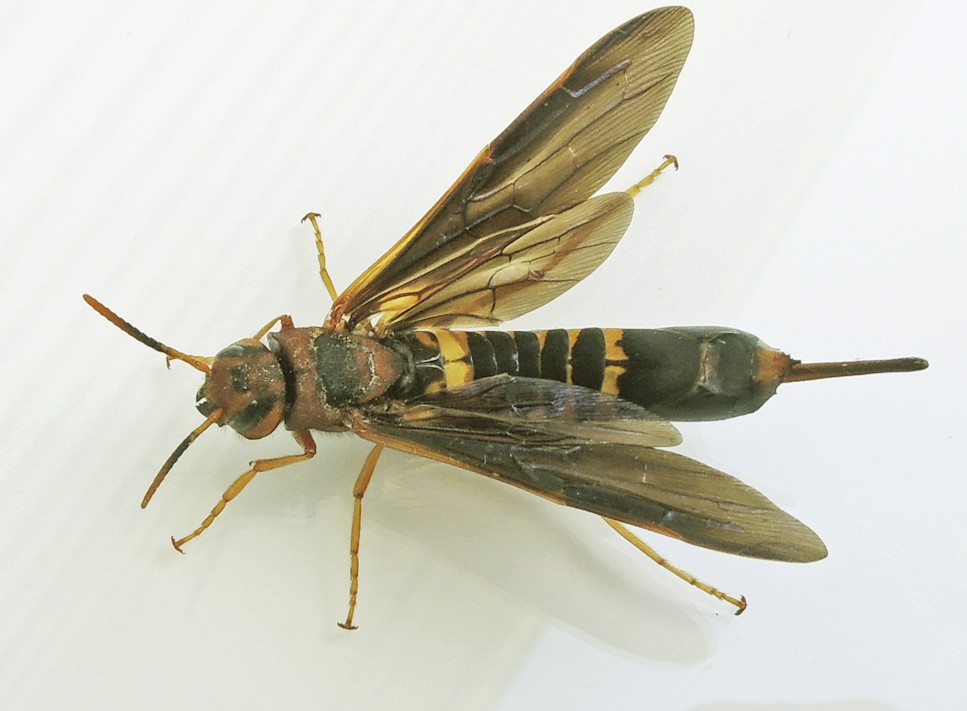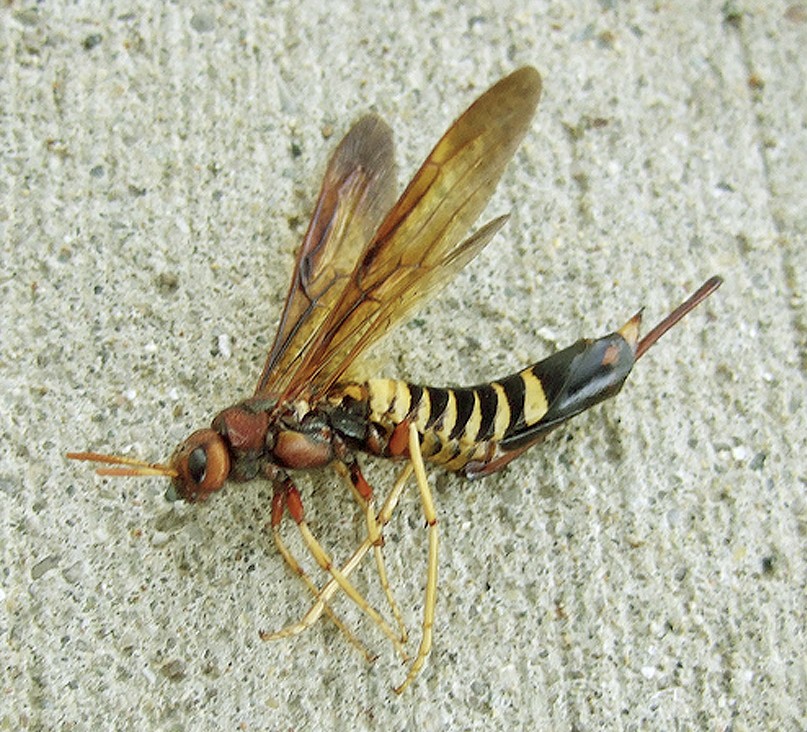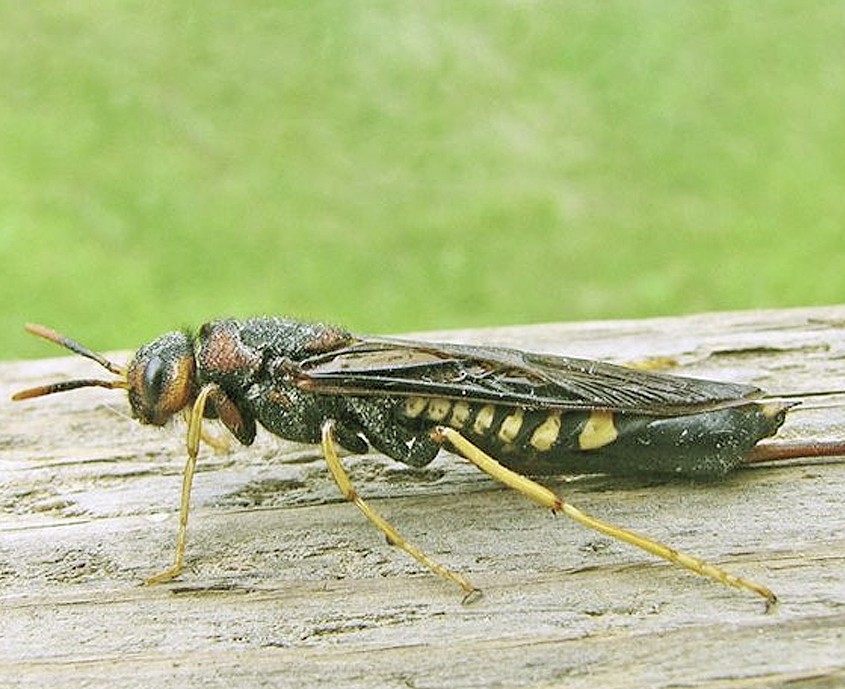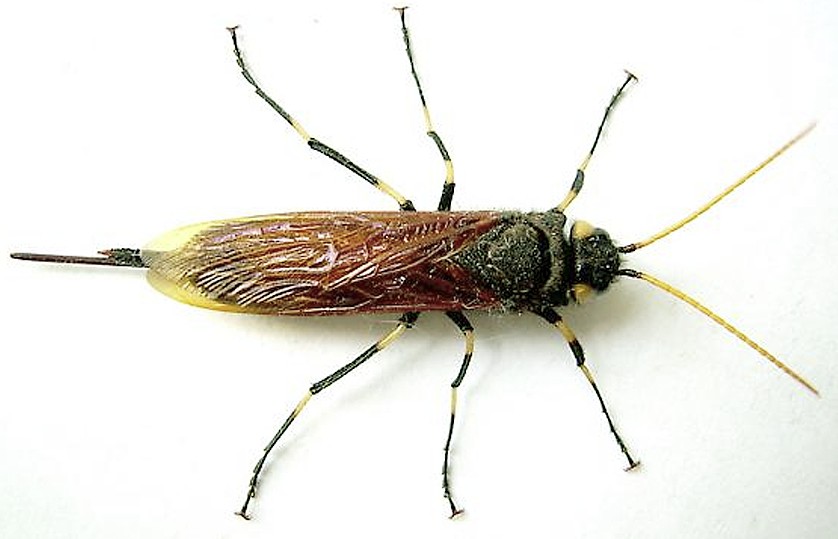Horntail
What is a Horntail?

Horntail or wood wasp is a common name of all of the 150 species of the Siricidae family. They belong to the Hymenoptera order, which is a type of xylophagous sawfly. This family was formerly an only living representative of the Siricoidea superfamily. These wood wasps are known widely for its nature of wood-boring and nesting. The most significant concerns of these Wasps are their behavioral nature of burrowing into the woods of the trees. However, it often goes unnoticed. In some cases, there were reports that the mature horntails are emerging from processed woods that are used in building homes. These insects are found across the USA, but the more significant number of them were found in California, Oregon, and Washington.
Identification of Horntail Wasp

The small Horntail wasps are half of the sizes of the great horntail wasp. These insects have pale brown legs, and the rest of the body has a color of metallic blue-black. However, it is very challenging to identify these insects in terms of color. Their appearance can vary from the colors mentioned above to red or brown. The markings, however, are typically amber or yellow. They usually have a thicker portion of the waist than the other wasps. Yet, they have a non-stinging nature. Despite that, though, the females often look intimidating than the other species. Well, this might be because of their large ovipositor the only function of which is to lay eggs. These ovipositors sometimes are large from their body, and though the white and sharp ovipositors seem to be dangerous, they cannot be used to sting humans. All the wasps are of the same sizes. However, females might look longer because of their ovipositors.
The female insects pierce the skin of pine trees to lay eggs. The female finds a relatively weaker tree and then settles on the bole turning her boring instrument ion hinge and then drives through the thick barks of the tree. Although it seems remarkable for such small female insects to pierce through such hard and resistant surface like tree bark, it is not that tough. The females keep doing experimental purpose before she lay her eggs. And if she could not find the tree suited for her use even after several attempts of punctures, she goes to another tree. This is how the female insects find trees that have fell to become the doors and the windows of our houses, and this is how the new generation wood wasps enter our new build houses.
Eating Habits
Horntail larvae, once after getting free from the egg, move its way upwards to eat the softer woods and then it comes back to go deeper inside the trunk. The larvae eat for almost a year while living inside the tree trunk. These larvae begin with the fungus-ridden woods immediately after getting out of the hatched eggs and then progress upwards consuming the softwoods until the bark. And then they gain come back and finish feeding and development. Another species of the horntail, the European Wood Wasps feed on living tree specimen than the dead timber too.
Typical Habitat of Wood wasps
There is not much information available about the habitat of horntail. However, they are mostly found in rainforests and inland wetlands as those are the places where they can find more weak trunks. The European wood wasp variation has just introduced on the east coast of the United States of America.
Signs of Horntail wasp Infestation
Unlike most of the other wasps, horntail wasps do not construct nests in the ground or attach one to the high terraces. This species, however, finds decaying and weakened tree trunks, logs and timber and inject the wood directly into it. A fungus included with the eggs is used to break down and soften the wood until the larvae emerge. The larvae then, as mentioned before, eat the trunk, starting from the weaker and softened woods and go upwards until the bark. Then coming back and going deeper into the trunk. This feeding and nesting process can take up to a year. This way, it is hard to tell if horntail wasps are nesting in your home or your garden or not.
In some cases, female horntails lay their eggs in a living tree specimen or directly in the processed wood that is going to use for making homes. This is another way that the horntails enter our home.
Here are a few common signs to tell if there is a horntail infestation in your house or not.
- Exit holes in a tree trunk: The adult horntails are disturbing when emerged in the living space. The exit holes in the tree trunk can be a big sign of horntail infestation as the adult horntails appear outside from them. However, these exit holes are tough to discover, especially when the wood has painted or stained.
- Noise: Horntails makes a lot of noises while flying.
Pictures
Here are some more Pictures of Horntails:





How to get rid of Horntails?
In most of the cases, you don’t have to do anything to get rid of the horntails. The adult horntails do not re-infest seasoned wood. They will not lay eggs in a house. And the damaged wood can often be repaired and replaced. However, here is a prevention tip if you may want to check.
Prevention
Homeowners can try storing firewood outside the home and only bring them inside when needed. These might help in the prevention of horntail wasp.
Facts
- These insects are from the Siricidae family and are the only living insects from the Siricoidae superfamily.
- Horntails are no longer than half to two inches.
- These are wasp-like insects and have a taillike spine that projects from the abdomen tip.
- Female horntails have white and sharp ovipositor that is only used to lay or inject eggs inside decaying tree trunks.
- The larvae are fed on soft fungus-ridden woods.
